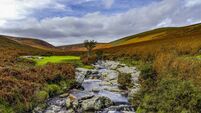Timing crucial for thinning broadleaf trees
Over the past decade there has been a continuous increase in the proportion of broadleaf forests being planted, with over 9,000 hectares of broadleaf species established in counties Kerry, Cork and Limerick since 2000.
It is vital that the first intervention to remove less favoured, competing trees is made at the appropriate time to ensure the development of future crop trees is not adversely affected.
Farmers at the national forestry demonstration at Cordal, Castleisland, Co Kerry heard there should be about 200 broadleaf trees per hectare in a well managed woodland at the end of a rotation. The remaining trees will have been removed as thinnings. In other words, 85% of all trees, or 50% of the volume in broadleaf woodland can and should be removed in thinnings over the commercial life of the crop.
Many broadleaf plantations are now approaching or are ready for thinning. It is vital that owners know when and how to commence this vital operation. Timber thinned from these woodlands can provide a valuable source of fuel as well as other products as the crop develops.
Issues discussed last week included grant schemes, costings and prices, felling licences, harvesting grants, forest roads, wolf trees with wide-spreading crowns which can inhibit or prevent the growth of smaller trees, firewood processing, use of brash for production of kindling, and furniture production from home grown broadleaf timber.
This is a good time for sheep farmers to look back on the lambing season and assess what went well, and what did not go so well and could be improved for future years.
Consider writing out a list of the problems that occurred while they are still fresh in the mind, and consider how these can be corrected for next year.
A strain not covered by the 8-in-1 vaccine has caused some ewe fatalities on the Teagasc sheep research demonstration farm in Athenry.
About 3% mortality in the run-up to lambing was due to a combination of causes including meningitis, prolapse, E coli, mastitis — and the clostridial strain sordellii, which was identified following post mortem in the regional vet lab.
Following veterinary advice on sordelli, ewes will be changed to the 10-in-1 vaccine, with lambs vaccinated at six weeks of age.












